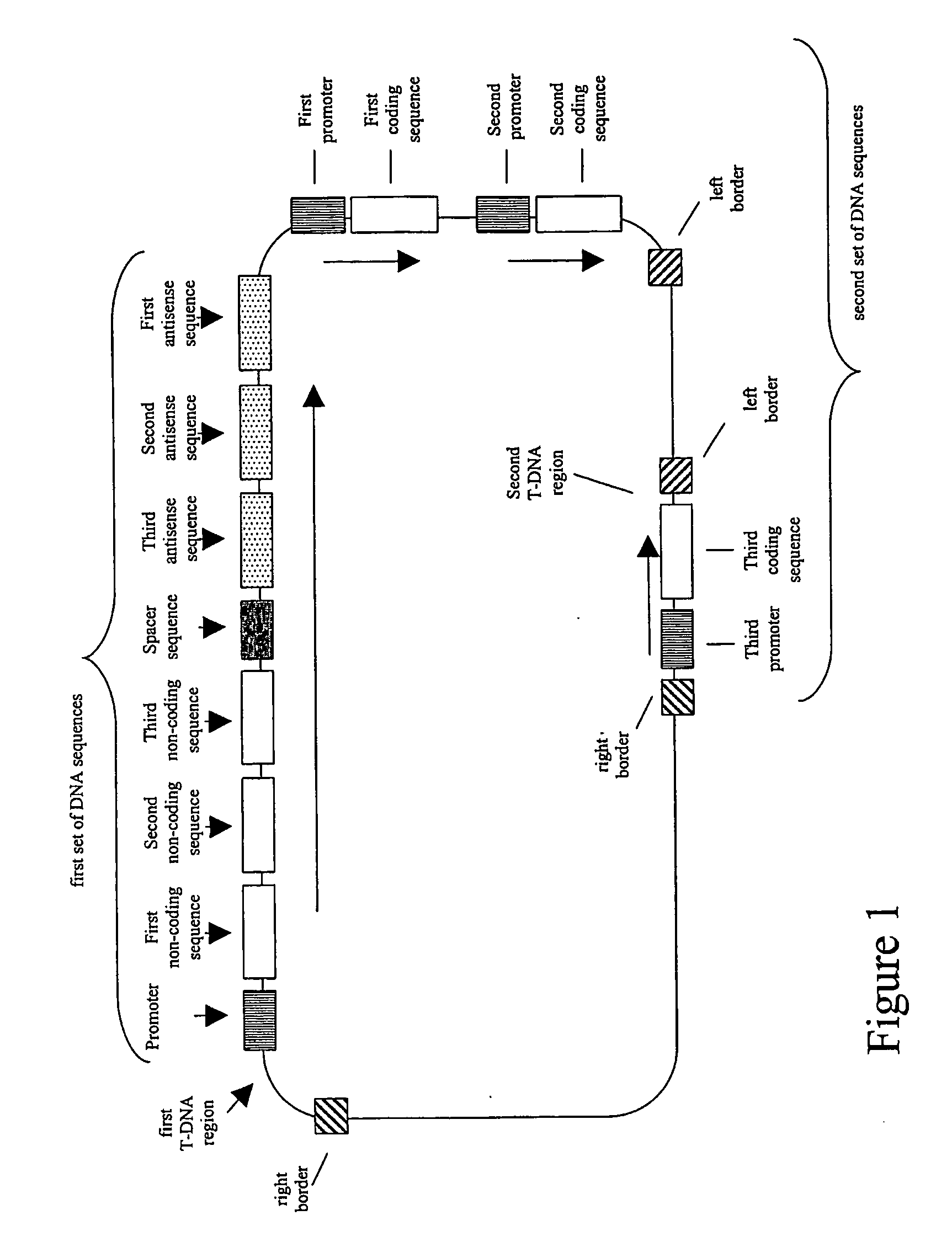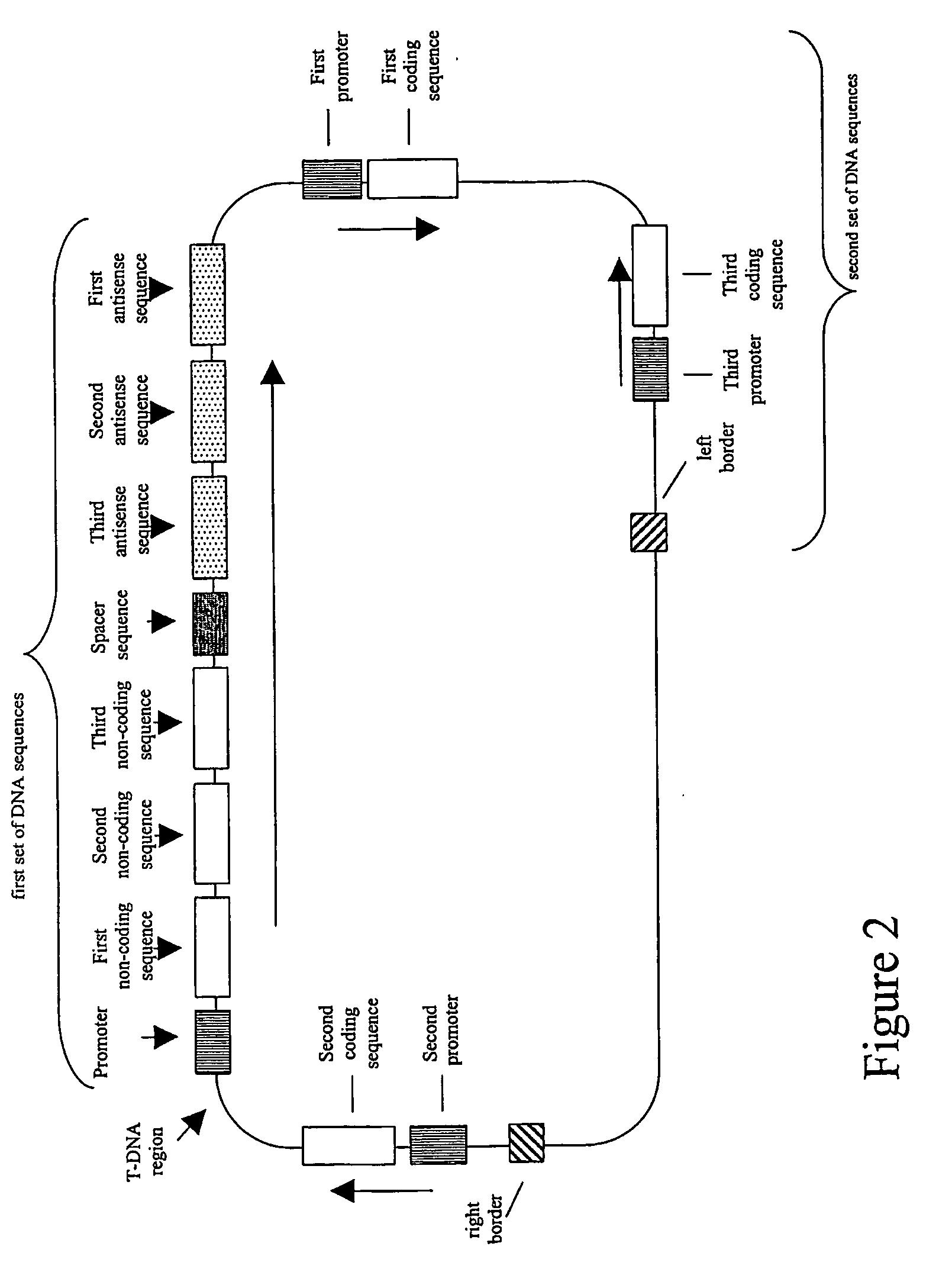Nucleic acid constructs and methods for producing altered seed oil compositions
a technology of nuclear constructs and modified seed oil, which is applied in the direction of enzymology, enzymology, transferases, etc., can solve the problems of insufficient availability lack of important food quality properties, and high cost of prior soybean oil, so as to increase the oleic acid content, suppress the endogenous expression, and increase the endogenous expression
- Summary
- Abstract
- Description
- Claims
- Application Information
AI Technical Summary
Benefits of technology
Problems solved by technology
Method used
Image
Examples
example 1
Suppression Constructs
1A. FAD2-1 Constructs
[0151] The FAD2-1A intron (SEQ ID NO: 1) is cloned into the expression cassette, pCGN3892, in sense and antisense orientations. The vector pCGN3892 contains the soybean 7S promoter and a pea rbcS 3′. Both gene fusions are then separately ligated into pCGN9372, a vector that contains the CP4 EPSPS gene regulated by the FMV promoter. The resulting expression constructs (pCGN5469 sense and pCGN5471 antisense) are used for transformation of soybean.
[0152] The FAD2-1B intron (SEQ ID NO: 2) is fused to the 3′ end of the FAD2-1A intron in plasmid pCGN5468 (contains the soybean 7S promoter fused to the FAD2-1A intron (sense) and a pea rbcS 3′) or pCGN5470 (contains the soybean 7S promoter fused to the FAD2-1A intron (antisense) and a pea rbcS 3′) in sense or antisense orientation respectively. The resulting intron combination fusions are then ligated separately into pCGN9372, a vector that contains the CP4 EPSPS gene regulated by the FMV promot...
example 2
Combination Constructs
[0161] In FIGS. 7-15, promoters are indicated by arrows, encoding sequences (both coding and non-coding) are indicated by pentagons which point in the direction of transcription, sense sequences are labeled in normal text, and antisense sequences are labeled in upside-down text. The abbreviations used in these Figures include: 7Sa=7Sα promoter, 7Sa′=7Sα′ promoter, Br napin=Brassica napin promoter; FMV=an FMV promoter; ARC=arcelin promoter; RBC E9 3′=Rubisco E9 termination signal; Nos 3′=nos termination signal; TML 3′=tml termination signal; napin 3′=napin termination signal; ‘3 (in the same box as FAD or FAT)=3′ UTR, 5′ (in the same box as FAD or FAT)=5′UTR; Cr=Cuphea pulcherrima; Gm=Glycine max; Rc=Ricinus communis; FAB2=a FAB2 allele of a stearoyl-desaturase gene; and Intr or Int=intron.
2A. dsRNA Constructs
[0162]FIGS. 7-9 depict nucleic acid molecules of the present invention in which the first sets of DNA sequences are capable of expressing dsRNA constru...
example 3
Plant Transformation and Analysis
[0200] The constructs of Examples 1 and 2 are stably introduced into soybean (for example, Asgrow variety A4922 or Asgrow variety A3244 or Asgrow variety A3525) by the methods described earlier, including the methods of McCabe et al., Bio / Technology, 6:923-926 (1988), or Agrobacterium-mediated transformation. Transformed soybean plants are identified by selection on media containing glyphosate. Fatty acid compositions are analyzed from seed of soybean lines transformed with the constructs using gas chromatography. In addition, any of the constructs may contain other sequences of interest, as well as different combinations of promoters.
[0201] For some applications, modified fatty acid compositions are detected in developing seeds, whereas in other instances, such as for analysis of oil profile, detection of fatty acid modifications occurring later in the FAS pathway, or for detection of minor modifications to the fatty acid composition, analysis of ...
PUM
| Property | Measurement | Unit |
|---|---|---|
| volume | aaaaa | aaaaa |
| volume | aaaaa | aaaaa |
| volume | aaaaa | aaaaa |
Abstract
Description
Claims
Application Information
 Login to View More
Login to View More - R&D
- Intellectual Property
- Life Sciences
- Materials
- Tech Scout
- Unparalleled Data Quality
- Higher Quality Content
- 60% Fewer Hallucinations
Browse by: Latest US Patents, China's latest patents, Technical Efficacy Thesaurus, Application Domain, Technology Topic, Popular Technical Reports.
© 2025 PatSnap. All rights reserved.Legal|Privacy policy|Modern Slavery Act Transparency Statement|Sitemap|About US| Contact US: help@patsnap.com



